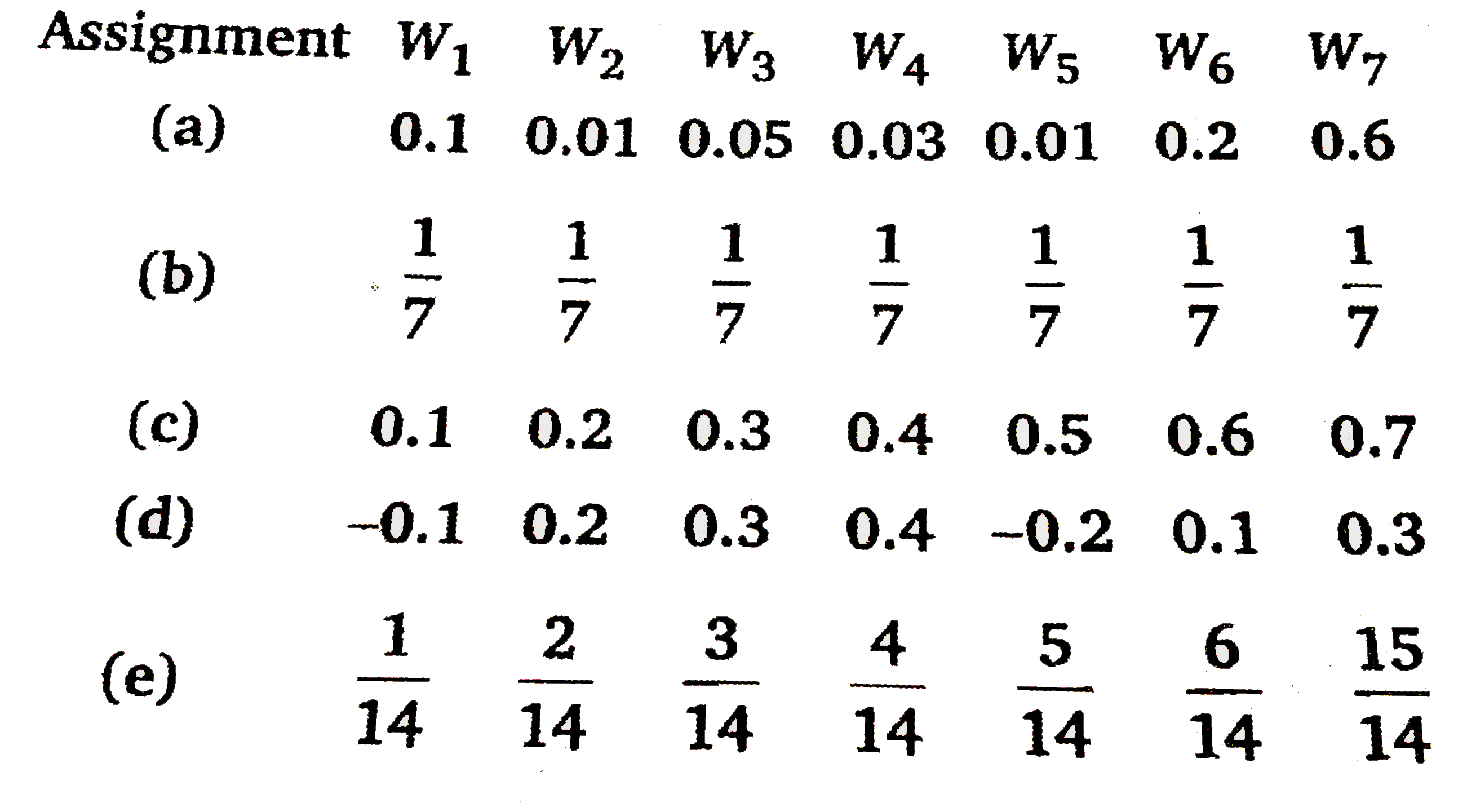A sample space consists of 9 elementary outcomes outcomes E1,E2,…,E9 whose probabilities are:
P(E1)=P(E2)=0.09,P(E3)=P(E4)=P(E5)=0.1,P(E6)=P(E7)=0.2,P(E8)=P(E9)=0.06
IfA={E1,E5,E8},B={E2,E5,E8,E9} then
(a) Calculate P(A),P(B), and P(A∩B).
(b) Using the addition law of probability, calculate P(A∪B).
(c ) List the composition of the event A∪B, and calculate P(A∪B) by adding the probabilities of the elementary outcomes.
(d) Calculate P(¯¯¯B) from P(B), also calculate P(¯¯¯B) directly from the elementarty outcomes of B. Solution in Bengali
(a) P(A)=P(E1)+P(E5)+P(E8)
=0.09+0.1+0.06=0.25
(b) P(B)=P(E2)+P(E5)+P(E8)=P(E9)
=0.09+0.1+0.06+0.06=0.31
P(A∪B)=P(A)+P(B)−P(A∩B)
Now, A∩B={E5,E8}
∴P(A∩B)=P(E5)+P(E8)=0.1+0.06=0.16
∴P(A∪B)=0.25+0.31−0.16=0.40
(c ) A∪B={E1,E2,E5,E8,E9}
P(A∪B)=P(E1)+P(E2)+P(E5)+P(E8)+P(E9)
=0.09+0.09+0.1+0.06+0.06=0.40
(d) ∵P(¯¯¯B)=1−P(B)=1−0.31=0.69
and ¯¯¯B={E1,E3,E4,E6,E7}
∴P(¯¯¯B)=P(E1)+P(E3)+P(E4)+P(E6)+P(E7)
= 0.09 + 0.1 + 0.1 + 0.2 + 0.2 = 0.69
Topper's Solved these Questions
- BOOK - CENGAGE PUBLICATIONCHAPTER - PROBABILITY I EXERCISE - Solved Example9videos
PROBABILITY I
- BOOK - CENGAGE PUBLICATIONCHAPTER - PROBABILITY I EXERCISE - Exercise 9.16videos
PROBABILITY I
- BOOK - CENGAGE PUBLICATIONCHAPTER - PROBABILITYEXERCISE - All Questions470videos
PROBABILITY
- BOOK - CENGAGE PUBLICATIONCHAPTER - PROBABILITY IIEXERCISE - MULTIPLE CORRECT ANSWER TYPE6videos
PROBABILITY II
Similar Questions
When a fair dice is rolled, the number that comes up top is a number between one to six. Assuming we roll the dice once, to check the possibility of three coming up.
06:27View SolutionWhich of the following cannot be valid assignment of probabilities for outcomes of sample space S={W1,W2,W3,W4,W5,W6,W7}
 02:45View Solution
02:45View SolutionA coin is tossed three times, consider the following events. A : ‘No head appears’, B: ‘Exactly one head appears’ and C: ‘Atleast two appear’. Do they form a set of mutually exclusive and exhaustive events?
07:58View SolutionLet EandF be two independent events. The probability that exactly one of them occurs is 1125 and the probability if none of them occurring is 225. If P(T) denotes the probability of occurrence of the event T, then (a) P(E)=45,P(F)=35 (b) P(E)=15,P(F)=25 (c) P(E)=25,P(F)=15 (d) P(E)=35,P(F)=45
02:15View Solution= E_ (1), E_ (2), E_ (3), E_ (1), E_ (5) and P (E_ (1)) = (95) / (100), P (E_ (2) | E_ (1)) = (93) / (99), P (E_ (3) | E_ (1) E_ (2) E_ (3)) = (92) / (97) and P (E_ (5) | E_ (1) E_ (2) E_ (3) E_ (4)) = (91) / (96) n P (E) equals
View SolutionIf E_(1) and E_(2) are events of a sample space such that P(E_(1))=(1)/(4),P((E_(2))/(E_(1)))=(1)/(2),P((E_(1))/(E_(2)))=(1)/(4) Then P((E_(1))/(E_(2)))=
05:55View SolutionA sample space consists of 9 elementary outcomes E1,E2,…..,E9 whose probabilities are
P(E1)=P(E2)=0.08,P(E3)=P(E4)=P(E5)=0.1
P(E6)=P(E1)=0.2,P(E8)=P(E9)=0.07
Suppose A={E1,E5,E8},B={E2,E5,E8,E9}
(i) Calculate P(A), P(B) and P(A∩B).
(ii) Using the addition law of probability, calculate P(A∪B).
(iii) List the composition of the event A∪B and calculate P(A∪B) by adding the probabilities of the elementary outcomes.
Calculate P(−B) from P(B), also calculate P(−B) directly from the elementary outcomes of −B,02:13View SolutionIf e1,e2,e3 and e4 are the four elementary outcomes in a sample space and P(e1)=0.1,P(e2)=0.5,and P(e3)=0.1, then the probability of e4 is ……
02:54View SolutionA sample space consists of 9 elementary outcomes outcomes E1,E2,…, E9 whose probabilities are:
P(E_(1))=P(E_(2)) = 0.09, P(E_(3))=P(E_(4))=P(E_(5))=0.1<br>P(E_(6)) = P(E_(7)) = 0.2, P(E_(8)) = P(E_(9)) = 0.06<br>IfA = {E_(1), E_(5), E_(8)}, B= {E_(2), E_(5), E_(8), E_(9)}then<br>(a)Calca––teP(A),P(B),andP(AnnB).<br>(b)Usingtheadditionlawofprobability,calca––teP(A uu B).<br>(c)ListthecompositionoftheeventA uu B,andcalca––teP(A uu B)byadd∈gtheprobabilitiesofthee≤mentaryoutcomes.<br>(d)Calca––teP(barB)omP(B),alsocalca––teP(barB) directly from the elementarty outcomes of B.05:39View SolutionIf E1 and E2 are two events such that P(E1)=1/4, P(E2/E1)=1/2 and P(E1/E2)=1/4, then
03:40View SolutionIf E1,E2, are independent events, such P(E1∩E2)=1/8,P(¯¯¯E1∩¯¯¯E2)=1/4, then P((E1+P(E2)=
06:32View SolutionThe two events E1,E2 are such that
P(E1∪E2)=58,P(¯¯¯E1)=34,P(E2)=12, then E1 and E2 are01:08View SolutionLet A, B,C be any three events in a sample space of a random experiment. Let the events E1= exactly one of A,B occurs, E2= exactly one of B ,c occurs, E3= exactly one of c ,A occurs, E4= all of A,B ,c occurs,E5= atleast one of A,B, c occurs P(E1)=P(E2)=P(E3)=13,P(E4)=19,P(E5)=
03:53View SolutionE1, E2 are events of a sample space such that P(E1)=14, P(E2E1)=12, P(E1E2)=14 then P(E1E2)+P(E1¯¯¯E2)=
02:06View SolutionA sample space consists of 9 elementary outcomes E1,E2,…..,E9 whose probabilities are
P(E1)=P(E2)=0.08,P(E3)=P(E4)=P(E5)=0.1
P(E6)=P(E1)=0.2,P(E8)=P(E9)=0.07
Suppose A={E1,E5,E8},B={E2,E5,E8,E9}
(i) Calculate P(A), P(B) and P(A∩B).
(ii) Using the addition law of probability, calculate P(A∪B).
(iii) List the composition of the event A∪B and calculate P(A∪B) by adding the probabilities of the elementary outcomes.
Calculate P(−B) from P(B), also calculate P(−B) directly from the elementary outcomes of −B,02:01View SolutionIf e1,e2,e3 and e4 are the four elementary outcomes in a sample space and P(e1)=0.1,P(e2)=0.5,and P(e3)=0.1, then the probability of e4 is ……
06:22View Solution

